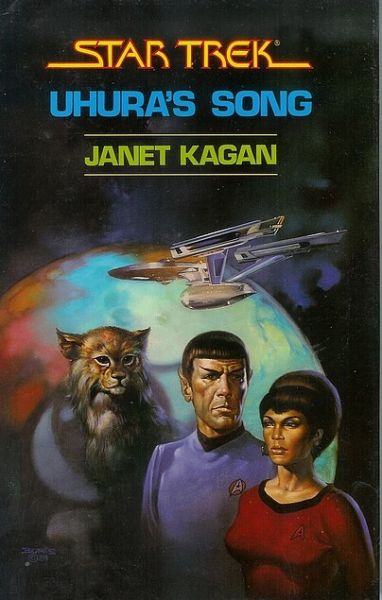Emergency Cases
Uhura’s Song
By Janet Kagan

22 Dec, 2020
Janet Kagan’s 1985 Uhura’s Song is a Star Trek: Original Series tie-in novel.
The starship Enterprise has been dispatched to Eeiauo, whose inhabitants have very reluctantly asked for help dealing with a virulent and quite deadly pandemic. This is not the first time ADF Syndrome has washed across this world — the last outbreak killed twenty thousand people — but it is the first outbreak that has forced the Eeiauoians to swallow their pride and ask for Federation aid.
A medical crisis would seem to be Doctor McCoy’s bailiwick. As it turns out, it is actually communications officer Lieutenant Uhura’s.
SPOILERS FOLLOW FOR THIRTY-FIVE-YEAR-OLD NOVEL
Multilingual Uhura learned Eeiauoian songs from Sunfall, an Eeiauoian friend. Not all of these songs were for public singing, although the reason why they might be scandalous was not always clear. Among the songs is one that suggests to Uhura that the Eeiauoians may not be native to the world they currently call home. Further, Uhura believes the cure for ADF may be found on the true home world of the felinoid aliens.
Spock soon confirms that evidence supports at least part of Uhura’s supposition. Not only do Eeiauoians appear to have no close relatives on-planet, but the fossil record shows no evidence of any animal that might have evolved into the Eeiauoians.
The next step is to ask the felinoids about their lost home world. At this point, the investigation hits a road block: the Eeiauoians absolutely will not discuss the matter. The catlike aliens were exiled long ago, but twenty-five centuries have not made them less touchy about the topic.
Determined to save the aliens despite themselves, Uhura and her fellow Star Fleet officers decide to search for the lost home world without Eeiauoian help. Using clues from the song, questionable data, and a frightening amount of conjecture, they manage to narrow the list of candidate worlds to a handful. One of them, Sivao, is the very world for which Starfleet is searching. The day is saved!
Except … the nomadic Sivaoans may differ culturally from the Eeiauoians in many respects, but they do agree on one thing: that to discuss that which needs to be discussed to save the Eeiauoians is anathema. Unless the crew of the Enterprisecan work out what the basis for the taboo might be and how to circumvent it, the Eeiauoians are doomed.
~oOo~
Nurse Chapel is also doomed, since she was the unlucky medic who learned the hard way that ADF can jump species. Chekov is also vulnerable to ADF. I suppose the idea was to endanger characters the readers know and like, rather than replying on empathy for a planet full of uncooperative strangers. Who, granted, are cats and can be excused for asking for the front door to be opened before refusing to go out.
Once McCoy is on Eeiauo, he absolutely refuses to break quarantine by returning to the Enterprise (which puts him one-up over every crewmember of the Nostromo save Ripley). Consequently, a lot of the heavy lifting McCoy would have done is performed by Doctor Evan Wilson, designated Tail-Kinker to-Ennien by the Sivaoans. Wilson is something of an enigma, because (this is the spoilery bit) she isn’t Wilson at all but someone borrowing the doctor’s identity. Whoever “Wilson” is [1], they know enough to pass themselves off as a Starfleet doctor without getting caught. The Wilson subplot feels like something that might have been developed further in subsequent novels—which goes against the tradition of mashing a big reset button at the end of each Star Trek episode — but never was.
The plot points to a curious absence in the Trek universe, which is that although there are a lot of civilizations in our part of the galaxy and while starfaring is an ancient art in the Trek setting, none of the star-travelling cultures seem to have bothered writing a comprehensive history of the region. Consequently, the Federation is forever being surprised by what it finds on its doorstep. This, no doubt, is why the Enterprise was dispatched on that famous five-year mission [3].
This is a perfectly functional Star Trek novel, although the author’s stated goal of giving Uhura some time in the spotlight is undermined somewhat by Wilson’s tendency to shoulder other characters off centre stage. I get the sense that other people liked this book a lot more than I did. I would have preferred that Kagan had spent more time writing books set in her own universes.
Uhura’s Songis available here (Amazon US), here (Amazon Canada), here (Amazon UK), here (Barnes & Noble), and here (Chapters-Indigo). It does not appear to be available from Book Depository.
1: Probably not Q, as they were not obnoxious enough by half. Maybe they were a bored Organian. You may remember the Organians as the advanced beings who forced a peace treaty on the Klingons and Federation; the treaty is referenced in Ford’s How Much for Just the Planet?,among many other places.
2: Possibly there are no histories because curiosity is deprecated. The Trek universe is about this far >< from cosmic horror. If you’re lucky, the godlike alien you encounter will settle for playing cruel games at your expense. If you’re unlucky, you just got assimilated by the Borg. There may be strong selective pressure against curiosity.
3: If curiosity is dangerous, why do humans persist in exploring? Well, possibly because humans are the Doc Browns of the galaxy and doing crazy-ass stuff to see what happens is our hat. Just don’t expect us to still be around in a thousand years.
